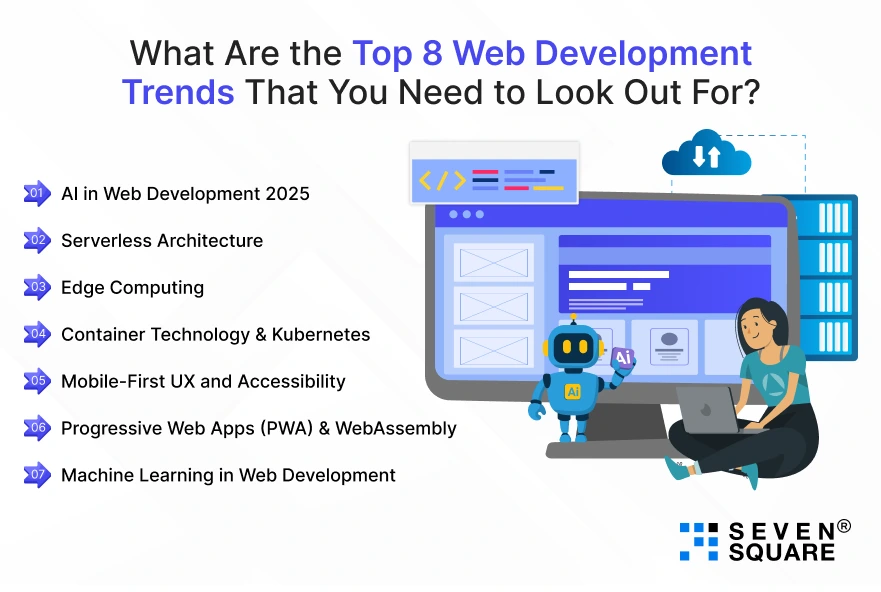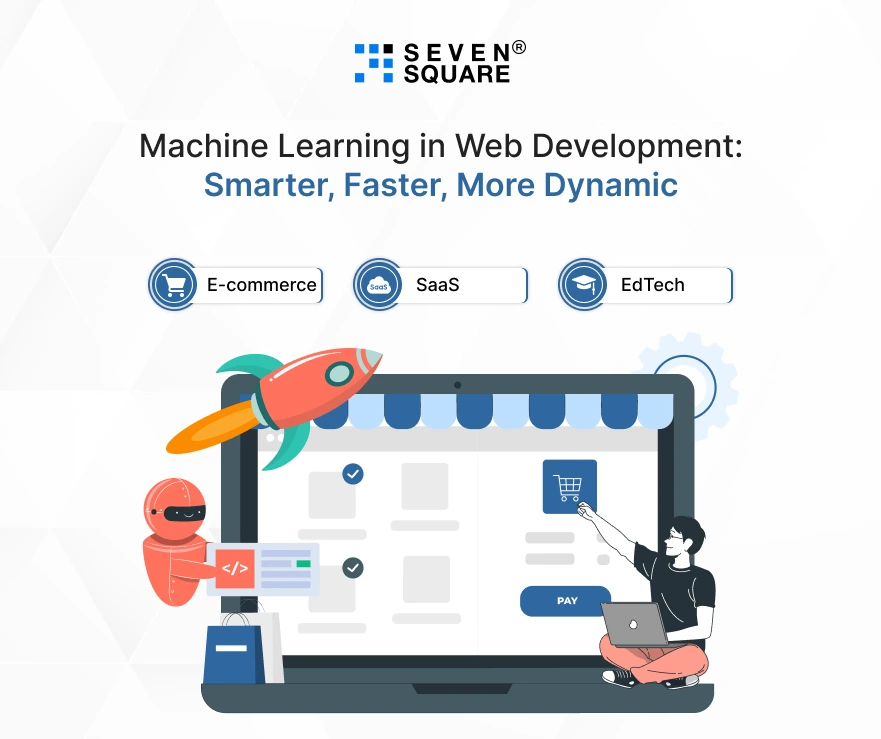The traffic dropped again last month. Load times are fine. The UI is clean. But users aren’t staying. What are we missing?
That’s a real Slack message we got from a startup founder recently. It wasn’t their product. It wasn’t their backend.
It was their outdated web stack built on tech trends that peaked in 2023.
In 2025, user expectations have evolved fast. Speed is the bare minimum. Personalization, security, and zero-friction experiences are non-negotiable.
And if your web development strategy isn’t catching up, your business is losing clicks along with its relevance.
At Seven Square, we’ve helped businesses across logistics, healthcare, education, and SaaS go through these changes with clarity.
This blog not only shows top web development trends, but it also reflects what we’re applying today.
Here are the top 8 web development trends for 2025 that you must know to stay ahead.
What Are the Top 8 Web Development Trends That You Need to Look Out For?

In 2025, web development isn’t just about building beautiful interfaces; it’s about creating intelligent, secure, scalable experiences that keep users coming back.
Here, we’re sharing the top 8 web development trends in 2025 that are making a difference:
1. AI in Web Development 2025: Beyond Chatbots
Artificial intelligence is not just about chatbots and recommendation engines anymore.
In 2025, AI plays a foundational role in web development, from development pipelines to user-facing interfaces.
We’re now using AI to power natural language search, predictive interfaces, real-time UI personalization, and even automated accessibility improvements.
From a business standpoint, integrating AI into a SaaS application improves customer retention by offering dynamic, user-specific experiences.
AI-powered dashboards, heatmap-based personalization, and behavior-triggered workflows are now standard in modern web platforms.
How we’re using it at Seven Square:
- AI-generated test cases for faster QA cycles.
- Smart product filtering on eCommerce sites.
- AI-powered analytics for EdTech platforms.
If you’re not using AI to automate, optimize, or personalize in 2025, your competitors already have the edge.
Learn if AI Can Do U.S. Government Consulting Better.
2. Serverless Architecture: Scalability Without the Bloat
Serverless architecture is changing backend development in 2025.
Unlike traditional setups, where you manage and scale infrastructure manually, serverless computing lets you focus solely on writing business logic.
Services like AWS Lambda, Google Cloud Functions, and Azure Functions run your code only when needed, reducing cost and complexity.
Serverless architecture pairs perfectly with modern SaaS development. Why? Because it supports fast iteration, dynamic scaling, and low maintenance.
Real use case: We built a learning management system for a SaaS client entirely on serverless architecture, with dynamic functions for quiz grading, real-time notifications, and file uploads.
This helped reduce infrastructure costs by 45% and accelerated deployment cycles.
Serverless development also integrates smoothly with microservices and event-driven design.
It promotes a modular, API-first architecture that supports easier scaling and improved fault isolation.
Why it matters in 2025:
- Allows rapid MVP development.
- Cuts down the cost for infrequent workloads.
- Supports auto-scaling under high user traffic.
3. Edge Computing: Bringing Power Closer to the User
The need for speed has never been greater. In 2025, users won’t tolerate lag, especially in real-time apps, IoT dashboards, or SaaS analytics platforms.
That’s why edge computing is one of the biggest web development trends this year.
Edge computing processes data closer to the user to reduce latency and server load.
At Seven Square, we’ve implemented edge logic to:
- Localize content instantly.
- Speed up checkout on global eCommerce platforms.
- Provide real-time collaboration in design SaaS tools.
Benefits for founders:
- Better user experiences globally.
- Faster page loads, even in rural or high-latency regions.
- Reduced bandwidth and cloud storage costs.
Today, with mobile-first and real-time web apps, edge computing is not just an optimization; it’s a necessity.
4. Container Technology & Kubernetes: Orchestrating Modern Web Apps
Containers have revolutionized how we deploy applications.
In 2025, containerization is the foundation of modern DevOps, CI/CD pipelines, and multi-cloud deployments.
Docker, Kubernetes, and container-native tools are no longer just for enterprises; they’re helping agile SaaS startups too.
With Kubernetes, teams can automatically scale, monitor, and self-heal microservices in production.
At Seven Square, we use Kubernetes to:
- Manage containerized workloads across staging and production.
- Auto-scale React/Node.js microservices.
- Allow rolling updates with zero downtime.
Use case: For a FinTech SaaS platform, we implemented Kubernetes to handle dynamic workloads in trading hours, reducing latency during peak volumes.
Container tech also simplifies local development, testing, and deployment by packaging everything needed to run the app consistently across environments.
5. Mobile-First UX and Accessibility: More Than Just Responsive Design
Designing for mobile-first is no longer an option; it’s the expectation.
In 2025, more than 70% of web traffic originates from mobile devices, and Google’s mobile-first indexing reinforces that your mobile experience is your web experience.
But mobile-first today goes beyond simply stacking content vertically. Users want fast, thumb-friendly designs that feel like native apps.
At Seven Square, we implement mobile-first strategies that prioritize:
- Performance on low-bandwidth networks.
- Accessible navigation (WCAG 2.2 compliance).
- Voice search readiness and touch-first interactivity.
Real-world impact: A D2C brand we worked with saw a 28% drop in bounce rate after we redesigned their store for mobile-first engagement and accessibility.
In 2025, designing for mobile-first UX is about creating inclusive, accessible, and delightful digital products that meet users on their phones.
Explore Top 10 Flutter UI/UX Tips.
6. Progressive Web Apps (PWA) & WebAssembly: App-Like Experiences, Without the App Store
PWAs are the silent champions of modern web development.
They combine the best of web and mobile apps like offline support, push notifications, fast load times, & installability, without the need to go through App Store approval.
In 2025, PWAs are gaining even more traction thanks to WebAssembly (Wasm).
This low-level binary format allows you to run high-performance applications directly in the browser.
Think Figma-level responsiveness or gaming engines powered through PWAs.
How we use this at Seven Square:
- We build PWAs for startups that want to reach users fast without burning budget on native app development.
- Use WebAssembly to accelerate performance-heavy features (image editing, 3D rendering, video processing).
One eLearning platform we worked with achieved a 60% increase in user engagement after transitioning from a traditional site to a full-featured PWA.
7. Machine Learning in Web Development: Smarter, Faster, More Dynamic

Machine learning (ML) is moving from backend R&D labs into real-time user experiences on the web.
In 2025, ML allows web apps to learn from user behavior, adapt interfaces dynamically, and provide predictive assistance.
Where ML is making an impact:
- E-commerce: Predictive pricing, smart upselling, and visual search.
- SaaS: Anomaly detection, auto-categorization, churn prediction.
- EdTech: Adaptive learning paths, real-time feedback.
At Seven Square, we integrate TensorFlow.js, ML5, and custom ML APIs into our clients’ products, whether it’s classifying support tickets, offering next-best actions, or optimizing UX flows.
The beauty? You can now train and run models in-browser without requiring server-side ML engines.
Learn about Top 7 Machine Learning Libraries.
8. Security-First Web Design: Trust Is the New Conversion Rate
Security is no longer the developer’s responsibility alone; it’s a UX priority.
In 2025, privacy laws, phishing attacks, and AI-generated scams have made security-first design essential to user trust.
From encrypted sessions to biometric authentication, users expect visible, embedded security in their daily workflows.
Seven Square’s security-first approach includes:
- Default HTTPS and SSL pinning.
- Secure-by-design OAuth flows and token rotation.
- Real-time activity logging and suspicious behavior alerts.
We recently helped a healthcare SaaS integrate end-to-end encryption and biometric logins.
The result? Faster HIPAA compliance and increased patient trust.
Want to make sure your web platform is future-ready? Contact Us Now!
Build for What’s Next, Not What’s Now
The web is evolving rapidly. Falling behind isn’t a tech issue; it’s a business risk. At Seven Square, we don’t chase trends.
We adopt technologies that help businesses scale, secure, and serve users better.
Every product we build blends engineering with product thinking, speed with reliability, and innovation with clarity.
FAQs
- In 2025, the top web development trends include AI-powered development, serverless architecture, edge computing, Progressive Web Apps (PWAs), mobile-first UX, component-driven development, and machine learning in web apps.
- These technologies focus on faster performance, better scalability, and more personalized user experiences.
- AI in web development is used for code generation, content personalization, chatbots, predictive UX, and data-driven decisions.
- Tools like GitHub Copilot and AI-based testing frameworks speed up development cycles while enhancing user engagement.
- Mobile-first web development prioritizes mobile experiences first, where most users are.
- With Google’s mobile-first indexing and rising mobile traffic, responsive UI, fast loading, and accessibility are absolute essentials in 2025.
- Machine learning in web development enables smart search, real-time personalization, fraud detection, and predictive analytics.
- With tools like TensorFlow.js & ML APIs, developers can integrate intelligent features directly into the browser for a smoother user experience.